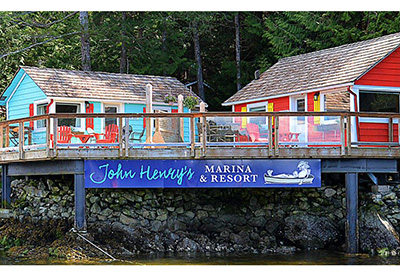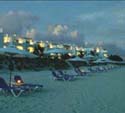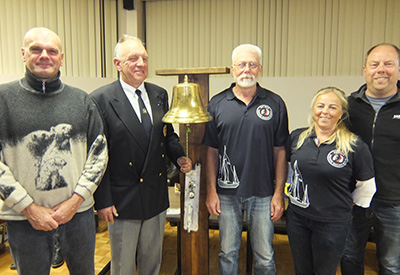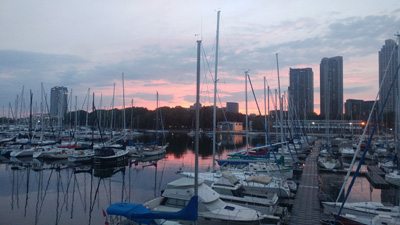An Intense Crossing

Feb 20, 2017
By Rob Dunbar
Approaching the Canso Causeway
After months of planning my trip to Prince Edward Island in my CL16 open sailing dinghy Celtic Kiss, departure day finally arrived. I greeted this much-anticipated day watching the sunrise from the comfort of my childhood home in Pirate Harbour.
Though I try to travel light I still managed to squeeze to Honda size carloads of provisions into the forepeak with a minute number of camping supplies secured onto the cockpit floor. With the boat weighed down and in good trim, I knew from previous experience that ‘Kiss would be would behave more like a keelboat then a small sailing dinghy when the weather dictated.
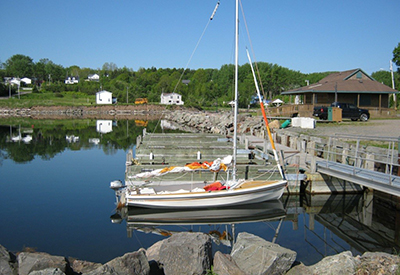 “Celtic Kiss”
“Celtic Kiss”
This trip was one of extremes. There was extreme wind and wave action on one end and a still glassy ocean on the other. There were also extreme currents that swiftly carried me to a destination and there were those that did their best to push me back from where I came.
Celtic Kiss and I departed the Mulgrave Marine Park in extreme still, glassy conditions. I had the option of either getting to the nearby Canso Causeway in speedy fashion or drift helplessly with my brilliant orange yellow and white sails hanging lifelessly from the new mast. And so, I started up the little Honda 2hp outboard and motored all the way to the Canal and transited through to the north side of the Strait of Canso.
When I arrived at the designated checkpoint C 28 locally known as Dixon rock I called to Canso Canal on channel 11 requesting a transit from south to north. The lockmaster asked me the usual questions: origin, destination, name of captain, number of persons onboard, citizenship, boat length and displacement in tonnes. This was the tricky question as I didn’t have a calculator to divide 2000 by 350 so with a bit of laughter it was marked down in the official log that Celtic Kiss has as a displacement of 1 tonne as far as the Canso Canal is concerned.
Just as I cleared the north gate of the canal I witnessed the birth of a gentle whisper of a breeze. Within minutes the whisper had grown to a steady breeze before maturing into a roaring wind. The roaring wind of 20 knots necessitated a quick reef but I soon concluded that the added ballast in Celtic Kiss eliminated the need for a reef. I shook out the reef and was soon beating upwind under full sail at a respectable 4.3 knots.
 Rob Dunbar at the Causeway
Rob Dunbar at the Causeway
Ballantynes Cove, my port of call for this leg of the journey is located on the eastern side of Cape George. Because of its location, Ballantynes Cove is a great jumping off point for crossing to Prince Edward Island. The mountain like Cape George is a conspicuous landmark on a clear day and can easily be seen from 30 miles away. Because the wind is blowing from the northeast I must sail a very high course so any leeway I encounter does not place me downwind of my intended destination.
The miles slowly tick away and six hours after exiting the canal the features along the shoreline expose themselves including the red banks of Ballantynes Cove.
The roaring wind of 20 knots quickly gained strength as I neared the headland and with eight miles to go a hissing monster appeared. The wind was easily 30 to 35 knots with whistling in the rigging and the reefed main flogging wildly. I was never afraid for my safety but I was genuinely afraid the mainsail would shake itself to death in the middle of St George’s Bay. What to do? Given the direction and velocity of the wind I dared not furl the jib. I needed the jib to pull me to safety and without the main, the jib would be too overwhelmed and I’d be blown back to the canal. My only option was to press on, as the motor was clearly no match for an angry St Georges Bay.
 On six occasions the ever-growing waves jumped over the bow, careened down the deck with such force that they slammed into the splash board. Rather than deflecting into the sea like the splash board is designed to do, the waves deflected upward, continued its way into the cockpit and drenched me in the process. Occasionally a wave would attack from abeam burying the windward chain plate and occasionally scoop a wave or two into the cockpit.
On six occasions the ever-growing waves jumped over the bow, careened down the deck with such force that they slammed into the splash board. Rather than deflecting into the sea like the splash board is designed to do, the waves deflected upward, continued its way into the cockpit and drenched me in the process. Occasionally a wave would attack from abeam burying the windward chain plate and occasionally scoop a wave or two into the cockpit.
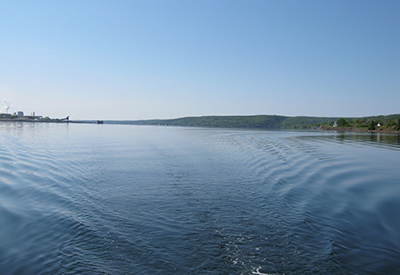 For twelve agonizing miles, Celtic Kiss punched through every wave like a main event boxer struggling for survival. It was very comforting to see the lobster buoys of the inshore fisherman appear as I knew I was no longer in desolation of Nova Scotia’s largest bay. This sight also comfort me as I reasoned that someone on shore is watching my brightly coloured sail bobbing up and down and help was not too far away. At long last I was able to navigate Celtic Kiss between the two breakwaters that define the protected Harbour at Ballantynes Cove where my father, who along with my mother drove from the Mulgrave Marine Park, took my bowline to successfully conclude this leg of extremes. Upon shedding my foul weather gear I noted I was soaked in sweat and salt water!
For twelve agonizing miles, Celtic Kiss punched through every wave like a main event boxer struggling for survival. It was very comforting to see the lobster buoys of the inshore fisherman appear as I knew I was no longer in desolation of Nova Scotia’s largest bay. This sight also comfort me as I reasoned that someone on shore is watching my brightly coloured sail bobbing up and down and help was not too far away. At long last I was able to navigate Celtic Kiss between the two breakwaters that define the protected Harbour at Ballantynes Cove where my father, who along with my mother drove from the Mulgrave Marine Park, took my bowline to successfully conclude this leg of extremes. Upon shedding my foul weather gear I noted I was soaked in sweat and salt water!
Next stop, Prince Edward Island



